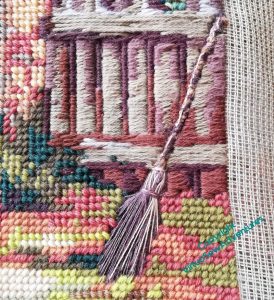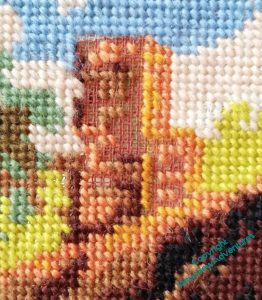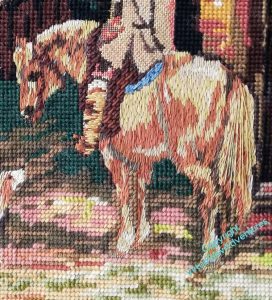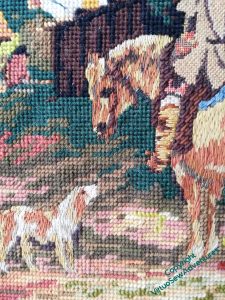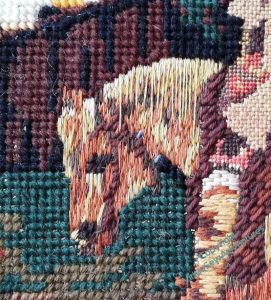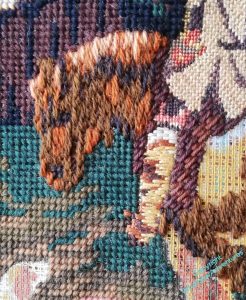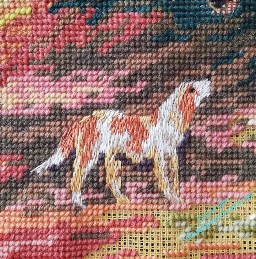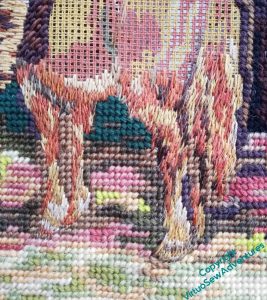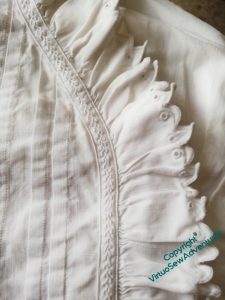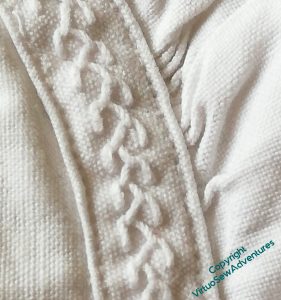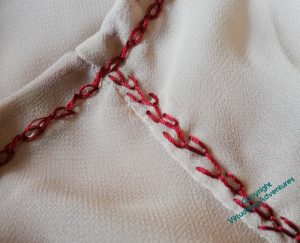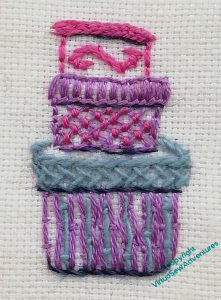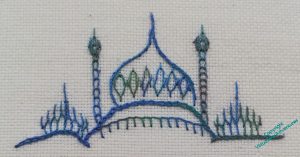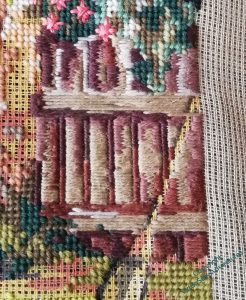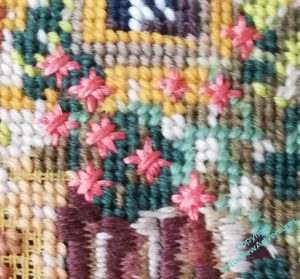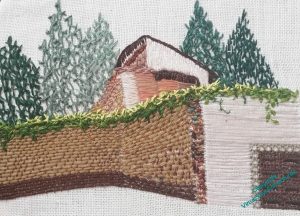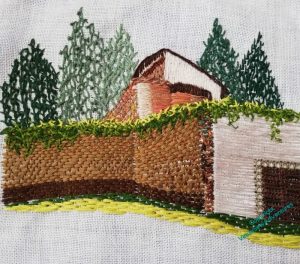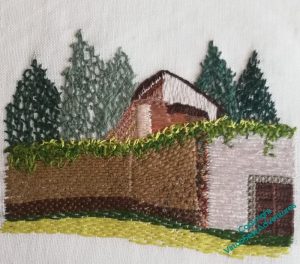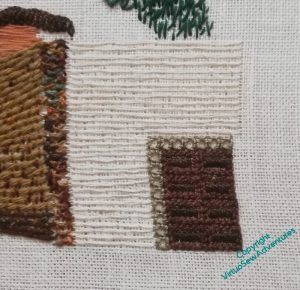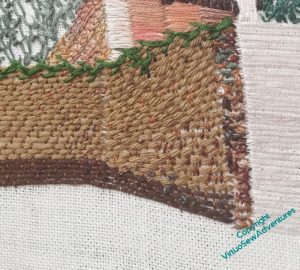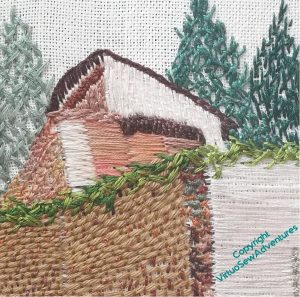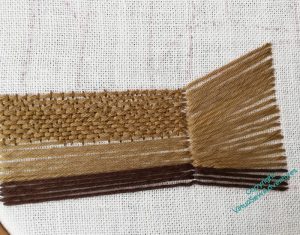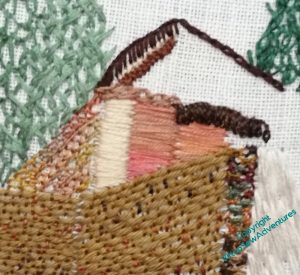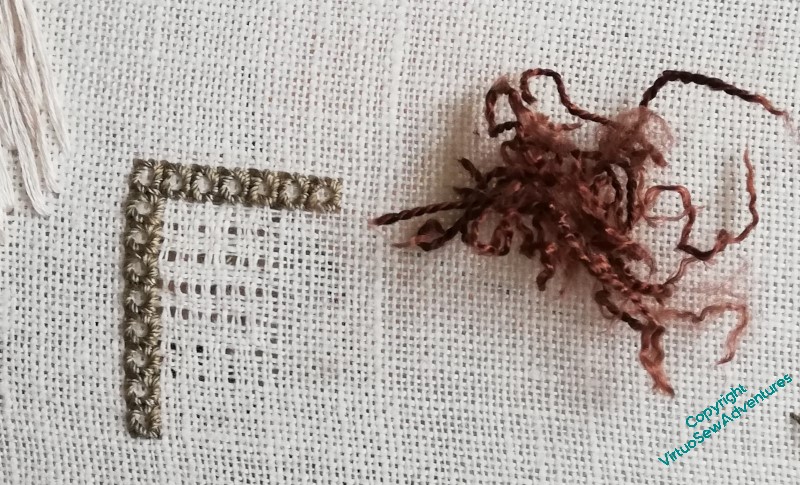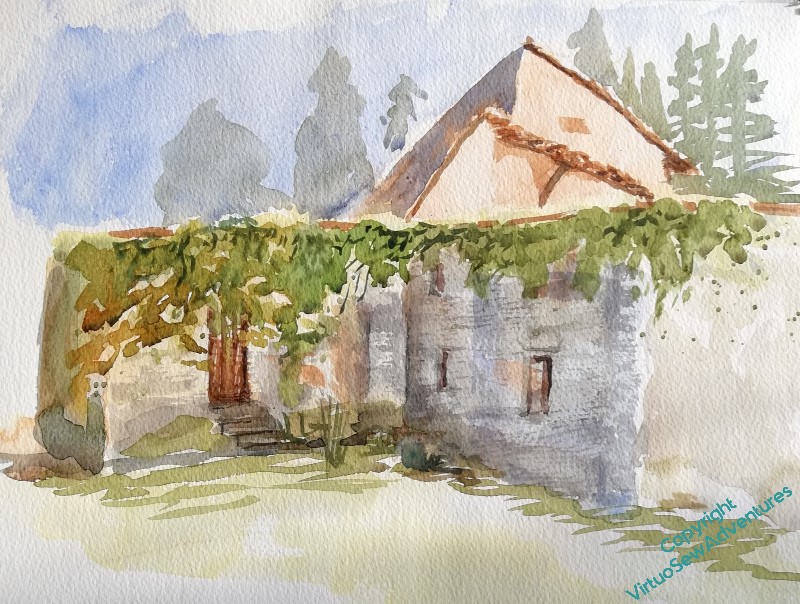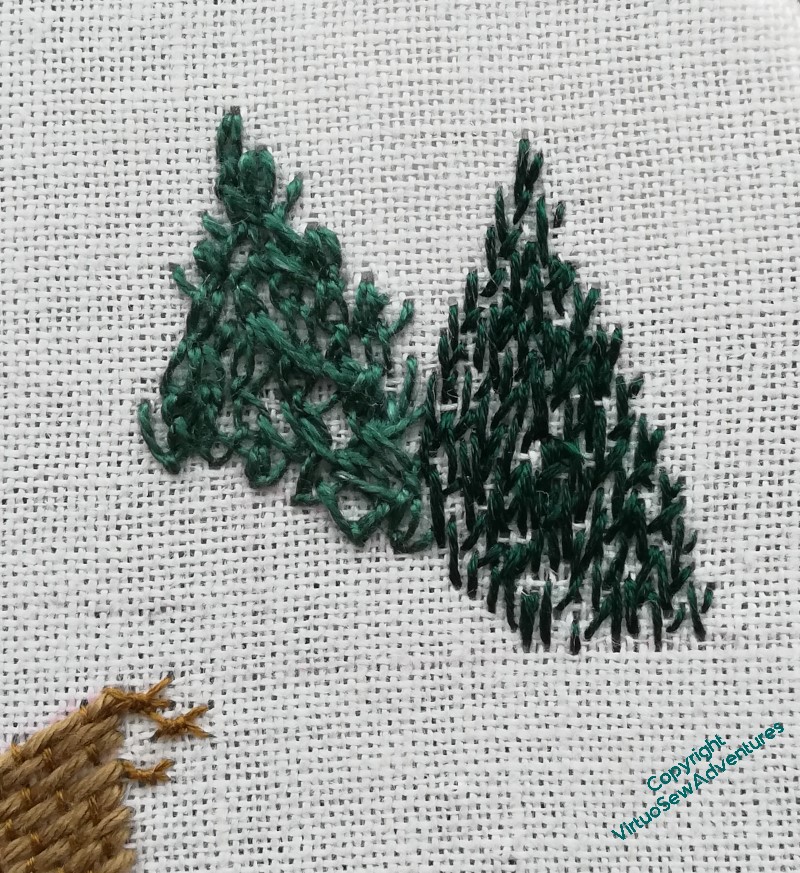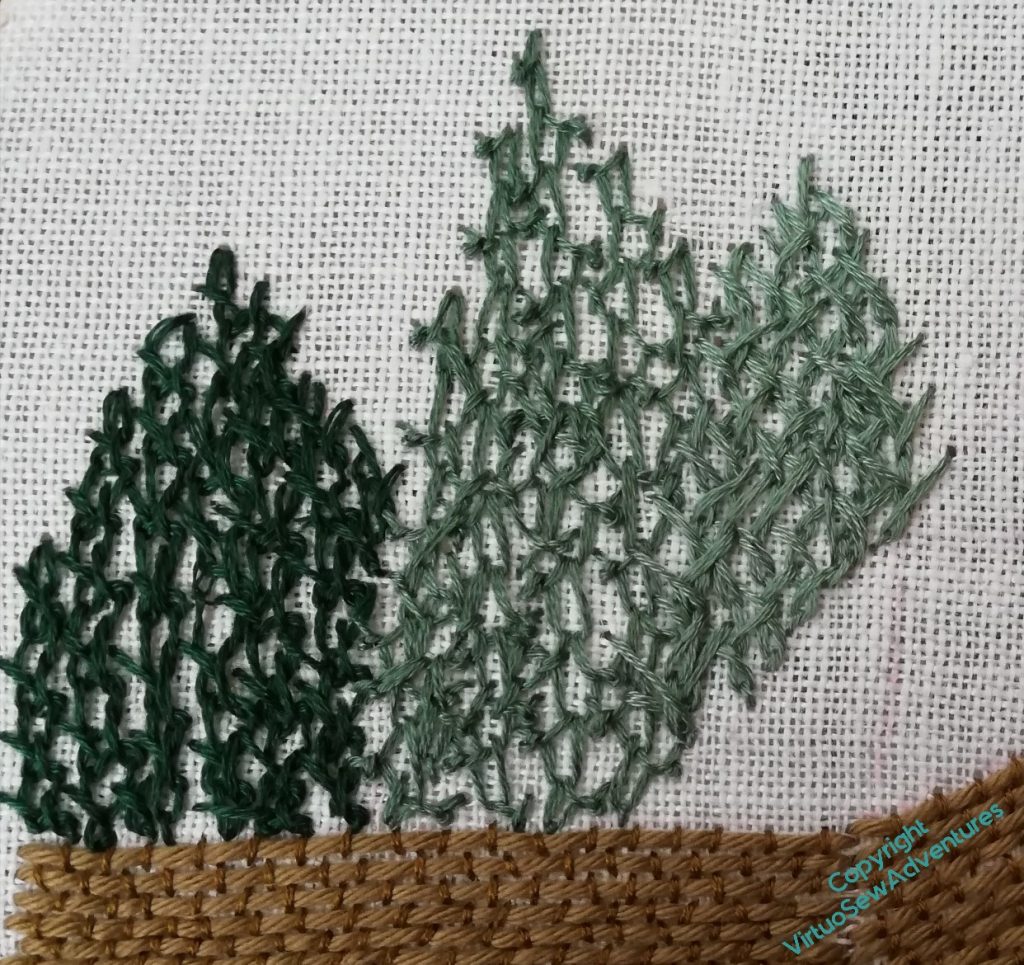Tag: stitches
Last details..
The birch besom leaning up against the fence rather caught my attention, because we had one when I was a little girl, and I’ve not seen another for years. Like all these low-tech looking things, it takes more to make one than you’d think, but they are good at what they’re good at.
They’re harder to make in stitches than you’d think, as well. I’ve used some fine unmercerised cotton, and some of that accursed stranded linen that DMC used to produce. Honestly, I’m all in favour of experimentation, but what one earth were they thinking? It’s ridiculously fragile, even on a fabric with huge holes, it’s uneven without being pretty, and it doesn’t even produce texture. But it was the colours I needed, and I didn’t want any shine…
At this point, I frolicked gently – it’s finished! – and took it off the frame.
Only to discover that, in fact, it wasn’t finished!
One colour of the chimney and a bit of one of the clouds remained unstitched. This wouldn’t have happened if I’d been working on it from the start, but as it was passed on by someone else, and I think, looking at the stitching, that at least two someones before me were involved, I’m not surprised to find bits missing. Fortunately, they weren’t hard to fix!
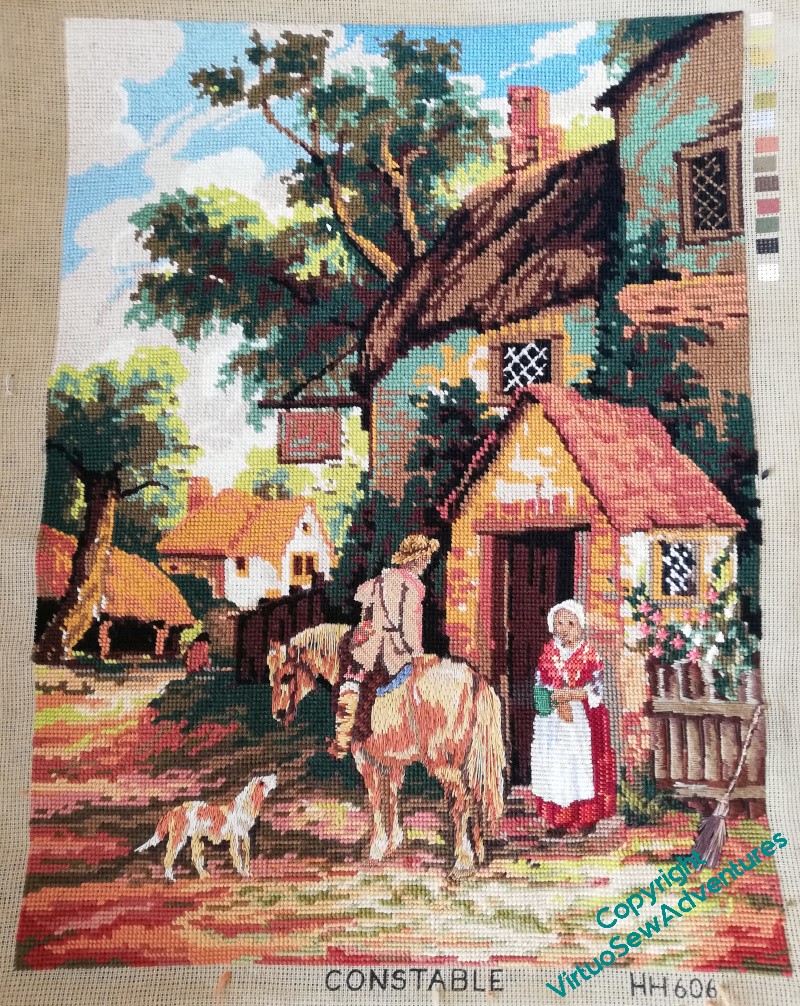
And now it really is finished! It’s turned out much better than it might have done, and it wants blocking and mounting in some way, but I think our local charity shop stands a chance of selling it once that’s done..
Update: my cousin is looking to furnish her office and has asked for it in return for a donation to my pet charity!
Dobbin
Dobbin covers quite a bit of the canvas!
Once I’d done all the masses of what for want of a better term I am going to call long and short stitch, using blends of stranded cotton, I sat back and looked.
I’ve added some long stitches to the tail, using two differently coloured strands of stranded cotton twisted together. I’m not sure whether to add more of this, or even whether to leave it in, but I wanted to help emphasize the length of the tail, and this is one way to do it.
The conversation is very clear to see now, I think. The colours are similar, but not the same, the technique is the same, and there is a real sense that Dobbin and the dog (Polly the pointer?) are having a proper catch-up.
I wonder what they are talking about?
Actually, once I looked at the conversation as it stands, I thought there was a little still missing…
That’s better.
It’s nothing like the thickness the mane would truly have, but I think it gives just the right recollection of the shaggy long hair of Dobbin’s mane, and the blue cotton on the harness and the back of the saddle suggest sunlight on the leather.
He’s turned out much better than I feared!
A second conversation
You may recall that I started on the horse in the canvaswork, and then suffered from Doubts. I thought it looked an unholy mess, and diverted my thoughts to the fence by the cottage. Which turned out very pleasingly, which is always a relief.
Then my cousin made a passing comment that helped me unstick the problem – she said that there are two conversations going on in the picture, one between the man and the woman, the other between the dog and the horse. That being the case, it seemed to me that I should maybe use the same technique for the dog and the horse, even the same sort of thread, so as to highlight the conversation.
I wanted to create the impression of fur, but nothing too shaggy, so while I wrestled with unpicking the horse, I started on the dog. Stranded cotton, separated and recombined using several close colours (I have a lot of stranded cotton, so this is all still stash), and then worked upward from the feet and the end of the tail in something a bit like long and short stitch.
I think this has worked well. We have friends whose dog is a similar shape and colouring to this one, and it was fun to sit and stitch with her in mind.
Of course, an entire horse (I’m calling him “Dobbin”, of course!) is going to take some time to do, since I need to work upwards. But at least I’ve made a good start here, smaller stitches around the hoof, longer stitches, with still longer ones planned, for the tail.
He’s a rough-coated working country horse, not a sleek and shining racehorse, so if the colours are clouded a bit, and the darks and lights not as distinct as they might be, that’s all to the good.
I’ve continued to work on the tent stitch, too, every which way, as it is in the sections already worked when I got the canvas, so the whole thing is getting closer to being finished..
Taking an idea from the past
Years and years ago, I bought a white cotton shirt and a long cotton petticoat at a vide-grenier in the Gers, where we were visiting a friend who was restoring an old farmhouse about a hundred yards from the route of the “Camino” to Compostela to run as a pilgrim hostel. I don’t wear either of them much, the petticoat being a little long, and the shirt a bit short in the arm, but I do occasionally just look at them to delight in the work that was put into them.
There is machine stitching on them – they’re not as old as all that! – but there is a lot of hand work too.
The careful reinforcement between the ruffle and the edge of the garment is a case in point, with a single length of neat feather stitches providing just the variation in texture it needs to stand out, subtly, but definitely. From a distance, it looks almost like a braid, but instead of being bought and applied, it was something the maker could do by themselves.
The ruffle itself is a super-simple version of broderie anglaise, a single eyelet within a pointed edge, hand-finished.
Well, now…
I don’t always do epic garments like the Jacket of Many Stitches or the Coat of Many Flowers, but sometimes I do decide that a garment needs a little bit of lift.
Expect to see rows of feather stitch popping up on assorted garments for the next several years!
Hashtags..
The Georgette Heyer ReadAlong on Twitter was one of the few truly delightful offspring of lockdown. Through it, I met a host of funny, feisty, warm, and loving women, intelligent and well-read, but not inclined to take that as a sole criterion for worth. Their take on almost everything is worth reading, they combine charity of heart with a refusal to take any nonsense, and they have improved everything about my experience of Twitter ever since.
We ended up with an entire sub-language of hashtags and references, and when the readalong came to an end, we embroidered some of them and one of us collaged them together as a gift for the lady who started it all. These are my contribution.
“Hatboxes” appear frequently in adventures, being small and portable containers that someone too young to have luggage might be able to pack with a few necessities. Mine turned into a positive sampler of stitches. The lid of the pink one is Hungarian Braided Chain, there is Trellis Couching, Herringbone Stitch, Burden Stitch, Blanket Stitch, Stem Stitch and Back Stitch.
“Fainting In The Pavillion” refers to an incident in one of the books when the heroine, overcome with heat and repugnance, faints in one of the rooms of Brighton Pavilion, greatly embarrassing her host, the Prince Regent (he had it coming, waste no sympathy!). This one includes Cretan Stitch, Open Chain (looking neat and delicate for once), Fly Stitches, Stem, Chain, and Blanket Stitch.
“Dashed Havey-Cavey” refers to suspicious and underhand circumstances, so rather than trying to illustrate it with a picture, I simply chose a dark and moody thread and put on my most pernickety mode of Reverse Chain Stitch.
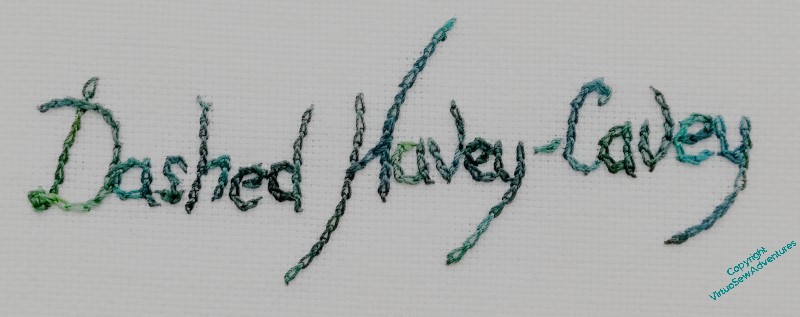
The whole thing was enormous fun, both to take part in, and to stitch about afterwards!
After which delight, it seems rather unfortunate that the latest video in SlowTV Stitchery, Episode 77, should be a sad one, full of struggle, and as yet not crowned by success..
The fence by the cottage
I intended to work the horse using Paterna, in something a little like long and short stitch, but having done his head, I looked at it and decided it needed a little more thought. It looks like some sort of unholy hybrid of horse and highland cow, and I wasn’t at all sure that it would look better when I’d done all of it. So I decided to divert my attention elsewhere and think about it for a little longer.
The most obvious element to tackle next was the fence, which is so far the only piece to be done in horizontal stitches. I’ve used soft cotton, which has nearly enough body to stand up to the tapestry wool, and slightly more sheen, which also helps. You’ve probably noticed that I haven’t extended my diversion to the broom, which looks a lot more like the birch besom my grandmama used to use in the garden. That’s likely to be last of all, as I want to raise it over the rest of the stitching.
Since I was working at this size of the canvas I was reminded that I’d been leaving gaps for some of the flowers. Diagonal Double Cross Stitch makes for some huge flowers, which might very nearly be the size of dinner plates if scaled up and aren’t at all cottagey – more Professor Branestawmy, in fact! – but they do stand out nicely against all the tent stitch, and they’ve enough personality to live with the fence, too..
Watermill Stitchery – Convento del Carmine
Once the walls were in place, I worked on the creepers.
As you can see here, this involved not just more of the same, but a few extra tendrils, and some mixing of the number of strands and stitches used to create the right tangled effect. Feather stitch, floral feather stitch, feathered chain stitch, all layered up in a variety of shades, to increase the tangle almost to “Sleeping Beauty” proportions.
Yes, good so far.
Then I decided that it really needed the grass at the front to pull the golden green forward, as it was in my memory.
Not like this, however. I think the choice of irregular running stitch is right, but although I chose to use six strands for the lighter colour to help pull it forward and push the building back – which is a good, rational, thought-through reason – it hasn’t worked as I envisaged. Cue some muttering and unpicking!
But I got there in the end…
In fact I’m very pleased with how this turned out. It allows me to demonstrate how to create different textural effects, even with a fairly restricted choice of thread – nothing exotic here, pearl cotton, soft cotton and stranded cotton.
I could add more details – roughen the stone further, add windows and doors to the walls in the shade – but I don’t think that the picture would be materially enhanced. And almost the whole trick with representative embroidery is the same as it is with painting: the finished piece is a new creation, not a copy of the thing it represents, so it is more important to end with a pleasing piece than an accurate report.
Watermill Stitchery – more progress on the Convento
I finally had a couple of inspirations for the rendered wall and the door. I used two shades of brown pearl cotton for the panels on the door, outlining them using long legged cross stitch, and filling in the panels with satin stitch. While I was doing that, it occurred to me that this was a good opportunity to demonstrate, again, just how different a stitch can look if you use different threads to stitch it with. So the render is rendered (sorry!) in Burden stitch, using two strands of light coloured stranded cotton, and already you can see how very different it looks in comparison with the soft cotton. It’s very satisfying when something works that well!
It was the golden light on the creeper that originally attracted me to this scene, so I need next to work out how to represent the creeper. I’m starting with feathered zig zag chain stitch, and I’ll use several colours of thread to create the variation of colour in the foliage.
I’ve added a few French Knots to the rough stone wall, to roughen it up a bit, and tweak the colour balance.
You can see here the start of the middle shade for the creeper, again using feathered zigzag chain stitch, and trying to zigzag the zigzags to vary how much of each colour shows.
You can also see that the facing light rendered wall is now done, and I have simply turned the Burden Stitch through ninety degrees. I think I may be beginning to be pleased with it!
Watermill Stitchery – continuing the Convento
Burden Stitch does a good job for the wall – you can see it starting here. I’ve used Soft Embroidery Cotton for the underlying straight stitch and a mixture of single strands of ordinary stranded cotton with one of the slightly heavier and more tightly twisted threads from Caron Collection, which has a whole series of warm red and brown colours with some greenish ones to help suggest the variation of colour in the stone wall. I’ve used darker soft cotton at the base of the wall, where there will be deep shadows on the lawn to “ground” the building.
The buildings showing above the top of the creeper-bedecked wall are all rendered rather than rough stone, and I had a bit of fun trying to pull together stitches and threads to represent the tiled roof, shadows under the eaves, the render and the woodwork. How pleased I am with how this section work changes day by day, so I shall leave well alone, until I’m either Definitely Dissatisfied or Supremely Satisfied!
In the bottom right hand corner, you can see the first attempt I made to depict the render on the facing wall, and the rough-cast feel of the turn of the wall. I’m not happy with the roughly-done, diagonal encroaching satin stitch, but I’m very pleased with the multicoloured mixture of French Knots, diagonal cross stitch, and Danish Knotted Cross stitch.
While I was rethinking the render, I worked on the door, which again, was not without missteps. The door surround, I am happy with – it’s Squared Chevron Stitch (found in one of my Edith John books), worked as a counted stitch. I then tried alternating two versions of Herringbone Stitch, hated it, and unpicked it promptly.
Oh, well, second mouse gets the cheese!
Watermill Stitchery – Trees at the Convento del Carmine
Very wisely, Bill and Lois, who run The Watermill At Posara, organise a variety of places to visit and paint, and in particular, the peace and quiet of the Convento del Carmine came the day after Excursion Day, which has people everywhere!!
I painted this watercolour when I was there, and in fact it shows something other than what I remember when I don’t look at it. What I mostly remember is dark foliage setting off the building in front, so for the embroidered version, that is what I intend to emphasize..
Now, remember, each of my Watermill Stitcheries is a sampler of experiments and ideas. I may or may not like all of them, but they should give my students points to ponder and places to start.
With that in mind, each of the trees is going to be in a different stitch. In each case I have worked vertical rows of the stitch, overlapping and interlocking them as best as I can to evoke the texture of the leaves.
I started, on the left, with Feathered Zigzag Chain Stitch. I’m quite pleased with this – you entirely lose the pattern of the stitch, but it evokes the movement of leaves in a breeze rather successfully.
I can’t say the same of Kerman Stitch, on the right. The breeze has stopped here, even if the impression of texture remains!
Working inward from the left, the first of these is Rabbit Eared Chain Stitch, found in Edith John’s “Creative Stitches”. This stitch is based on twisted chain stitches, which encouraged me to hope for a sense of movement again. I don’t think I quite hit the mark with it – maybe I never got quite comfortable enough with it – but I think it has possibilities.
The next one is Zigzag Crested Chain, again from Edith John. Crested chain is a stitch I enjoy but always find it moves under my needle. This time it ended up longer and thinner than I intended it to be – but maybe that was right for the purpose…
The final one is the slightly less peculiar Twisted Feather Stitch, and here, perhaps because it felt a little more familiar, more akin to the feathered zigzag chain I started with, I have my sense of movement and breeze back again.
I’ve begun the building in Burden Stitch, and now need to finish that, add more of the roof, and finally the creeper falling over the top of the wall. So watch this space!

